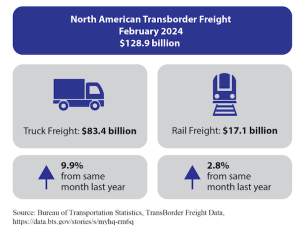While US railroads are engaging in multibillion-dollar efforts to enhance capacity, some rail executives believe it is time for marine terminals to operate on an around-the-clock basis.
Railway company officials expressed such a view Nov. 29 at the TOC 2005 Americas terminal operations conference and exhibition in Savannah, GA.
"Marine terminals need to run 24-by-7," said Frederick Malesa, Vice President of International Intermodal for Burlington Northern Santa Fe (BNSF) Railway, noting that railroads already run in the around-the-clock mode. At a minimum, he said, marine terminals should engage in rail loading 24-hours-a-day, seven-days-a-week.
John Kaiser, Vice President and General Manager for Intermodal at the Union Pacific Railroad, echoed that view, not only urging marine terminal partners to operate "24/7" as railroads do, but also to establish dedicated terminals for handling international freight.
Such intermodal service initiatives, to also include streamlined terminal handling processes and simplified train plans (including more single-destination trains), are necessary in addition to the high-dollar infrastructure investments being made to augment rail capacity, Kaiser said.
The rail industry is spending $9.5 billion this year ($2.8 billion by the Union Pacific alone) to add capacity, Kaiser said. He said the railroads can bear a total cost of $142 billion to add 24% to current capacity by 2020, but $195 billion is needed to provide the 47% capacity boost that federal studies indicate will be required by 2020. He urged the implementation of a rail infrastructure tax credit program as one means to help make the additional funds available.
Kaiser said the shipping industry has benefited from the trends that have occurred since rail deregulation under the 1980 Staggers Act. Between 1980 and 2003, according to Kaiser, the number of Class I railroads in the United States and Canada has been reduced to seven from 42, while rail productivity has increased 177%. Volume has increased 71%, revenue has decreased 34% and prices have decreased 60% in comparable "real" dollars.
"Freight railroads are the most capital-intensive industry in the United States," Kaiser said.
BNSF's Malesa said his railway company is spending more than $2.1 billion on its network this year, with much of that going toward double-tracking on its route between Los Angeles/Long Beach and Chicago.
He added that other moves are needed, too, including increasing the number of units per train, reductions in free storage time for cargo at terminals and broader introduction of neutral chassis pools.
"There is a tremendous opportunity to create even more capacity," Malesa said.
Speaking on the same panel, Ron Russ, Executive Vice President and Chief Financial Officer of the Kansas City Southern, said his company is looking to a pair of alternative gateways to serve growing demand.
One is via landbridge through the port of Lazaro Cardenas, on the Pacific Coast of Mexico. Russ said the Mexican port is actually closer by rail than Southern California to a number of key inland US destinations, including Atlanta (2,304 miles vs. 2,350 miles) and Houston (1,398 miles vs. 1,631 miles).
The second alternative involves Kansas City Southern's Panama Canal Railway Co. unit, which operates on tracks paralleling the canal.








